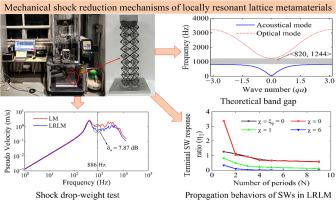Mechanical shock reduction mechanisms of locally resonant lattice metamaterials
IF 9.4
1区 工程技术
Q1 ENGINEERING, MECHANICAL
International Journal of Mechanical Sciences
Pub Date : 2025-09-20
DOI:10.1016/j.ijmecsci.2025.110864
引用次数: 0
Abstract
A novel locally resonant lattice metamaterial (LRLM) has been designed to meet multi-functional requirements by resolving the contradiction between high load-bearing capacity and efficient shock reduction, while ensuring reusability. This work presents the first investigation into the propagation mechanism of aperiodic oscillating (mechanical) shock loads in the LRLM, which fundamentally differs from the behavior observed under harmonic loads or transient blast/impact loads. The designed LRLM is composed of equivalent body-centered cubic (EBCC) lattices with high strength and local resonators generating tailoring band gap. The maximum relative difference in the pseudo velocity shock response spectra (PVSRS) corresponding to the LRLM and the lattice metamaterial (LM) without local resonators reaches 7.87 dB by the drop-weight test. The frequency range (<767, 1024> Hz) of the maximum shock reduction obtained by the drop-weight test is slightly smaller than that (<820, 1244> Hz) of the theoretical band gap (or negative mass density) obtained by its idealized dynamic model, and their error is attributed to the loose installations of local resonators. Furthermore, the propagation and attenuation of the shock-waveform (SW, which can be used to characterize any shock loads) with intense waveform effect in the LRLM are also investigated. The results indicate that shock reduction effects of the LRLM against SWs with larger waveform coefficients (WCs) are more remarkable than that against both harmonic waves and SWs with smaller WCs. The proposed SW shock reduction method underpins that LRLMs with vibration reduction effect can also be used to reduce shock loads as the protective structure in severe shock engineering fields.

局部共振晶格超材料的机械减震机制
设计了一种新型的局部共振晶格超材料(LRLM),解决了高承载能力和高效减震之间的矛盾,同时保证了材料的可重复使用性,满足了材料的多功能要求。这项工作首次研究了LRLM中非周期振荡(机械)冲击载荷的传播机制,它与谐波载荷或瞬态爆炸/冲击载荷下观察到的行为有着根本的不同。设计的LRLM由具有高强度的等效体心立方(EBCC)晶格和产生剪裁带隙的局部谐振器组成。落锤试验表明,LRLM与无局部谐振腔的晶格超材料(LM)对应的伪速度冲击响应谱(PVSRS)最大相对差达7.87 dB。落锤试验得到的最大减震频率范围(<767, 1024> Hz)略小于其理想化动力学模型得到的理论带隙(或负质量密度)的频率范围(<820, 1244> Hz),其误差是由于局部谐振器安装松散所致。此外,还研究了具有强烈波形效应的冲击波形(SW,可用于表征任何冲击载荷)在LRLM中的传播和衰减。结果表明,相对于谐波和波形系数较小的海浪,LRLM对波形系数较大的海浪的减振效果更为显著。本文提出的SW减振方法说明,具有减振效果的lrlm也可以作为防护结构用于剧烈冲击工程领域中降低冲击载荷。
本文章由计算机程序翻译,如有差异,请以英文原文为准。
求助全文
约1分钟内获得全文
求助全文
来源期刊

International Journal of Mechanical Sciences
工程技术-工程:机械
CiteScore
12.80
自引率
17.80%
发文量
769
审稿时长
19 days
期刊介绍:
The International Journal of Mechanical Sciences (IJMS) serves as a global platform for the publication and dissemination of original research that contributes to a deeper scientific understanding of the fundamental disciplines within mechanical, civil, and material engineering.
The primary focus of IJMS is to showcase innovative and ground-breaking work that utilizes analytical and computational modeling techniques, such as Finite Element Method (FEM), Boundary Element Method (BEM), and mesh-free methods, among others. These modeling methods are applied to diverse fields including rigid-body mechanics (e.g., dynamics, vibration, stability), structural mechanics, metal forming, advanced materials (e.g., metals, composites, cellular, smart) behavior and applications, impact mechanics, strain localization, and other nonlinear effects (e.g., large deflections, plasticity, fracture).
Additionally, IJMS covers the realms of fluid mechanics (both external and internal flows), tribology, thermodynamics, and materials processing. These subjects collectively form the core of the journal's content.
In summary, IJMS provides a prestigious platform for researchers to present their original contributions, shedding light on analytical and computational modeling methods in various areas of mechanical engineering, as well as exploring the behavior and application of advanced materials, fluid mechanics, thermodynamics, and materials processing.
 求助内容:
求助内容: 应助结果提醒方式:
应助结果提醒方式:


